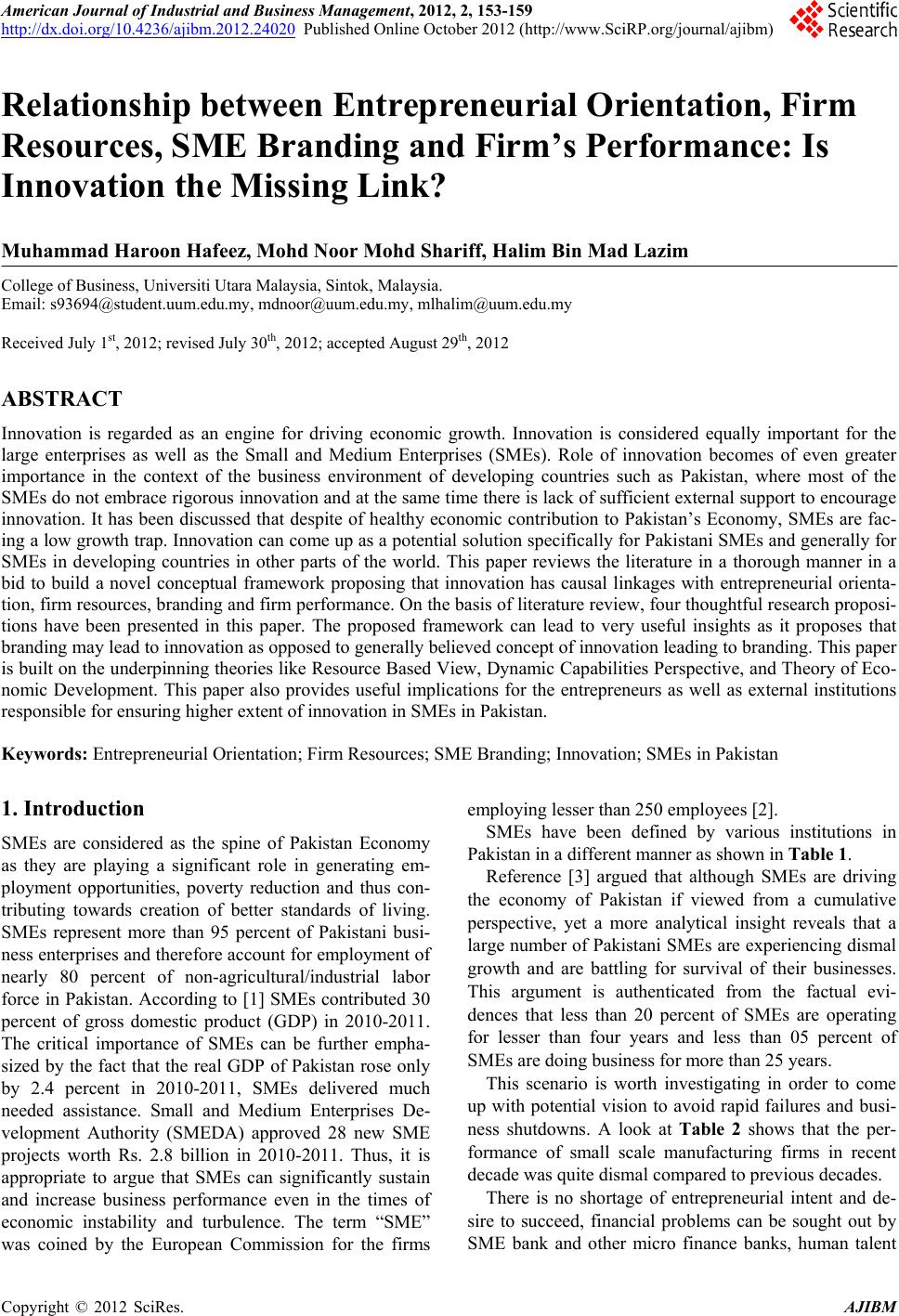 American Journal of Industrial and Business Management, 2012, 2, 153-159 http://dx.doi.org/10.4236/ajibm.2012.24020 Published Online October 2012 (http://www.SciRP.org/journal/ajibm) 153 Relationship between Entrepreneurial Orientation, Firm Resources, SME Branding and Firm’s Performance: Is Innovation the Missing Link? Muhammad Haroon Hafeez, Mohd Noor Mohd Shariff, Halim Bin Mad Lazim College of Business, Universiti Utar a Malaysia, Sint ok, Malaysia. Email: s93694@student.uum.edu.my, mdnoor@uum.edu.my, mlhalim@uum.edu.my Received July 1st, 2012; revised July 30th, 2012; accepted August 29th, 2012 ABSTRACT Innovation is regarded as an engine for driving economic growth. Innovation is considered equally important for the large enterprises as well as the Small and Medium Enterprises (SMEs). Role of innovation becomes of even greater importance in the context of the business environment of developing countries such as Pakistan, where most of the SMEs do not embrace rigorous innovation and at the same time there is lack of sufficient external support to encourage innovation. It has been discussed that despite of healthy economic contribution to Pakistan’s Economy, SMEs are fac- ing a low growth trap. Innovation can come up as a potential solution specifically for Pak istani SMEs and generally for SMEs in developing countries in other parts of the world. This paper reviews the literature in a thorough manner in a bid to build a novel conceptual framework proposing that innovation has causal linkages with entrepreneurial orienta- tion, firm resources, branding and firm performance. On the basis of literature review, four thoughtful research proposi- tions have been presented in this paper. The proposed framework can lead to very useful insights as it proposes that branding may lead to innovation as opposed to generally believed concept of innovation leading to branding. This paper is built on the underpinning theories like Resource Based View, Dynamic Capabilities Perspective, and Theory of Eco- nomic Development. This paper also provides useful implications for the entrepreneurs as well as external institutions responsible for ensuring higher extent of innovation in SMEs in Pakistan. Keywords: Entrepreneurial Orientation; Firm Resources; SME Branding; Innovation; SMEs in Pakistan 1. Introduction SMEs are considered as the spine of Pakistan Economy as they are playing a significant role in generating em- ployment opportunities, poverty reduction and thus con- tributing towards creation of better standards of living. SMEs represent more than 95 percent of Pakistani busi- ness enterprises and therefore account for employment of nearly 80 percent of non-agricultural/industrial labor force in Pakistan. According to [1] SMEs contributed 30 percent of gross domestic product (GDP) in 2010-2011. The critical importance of SMEs can be further empha- sized by the fact that the real GDP of Pakistan rose only by 2.4 percent in 2010-2011, SMEs delivered much needed assistance. Small and Medium Enterprises De- velopment Authority (SMEDA) approved 28 new SME projects worth Rs. 2.8 billion in 2010-2011. Thus, it is appropriate to argue that SMEs can significantly sustain and increase business performance even in the times of economic instability and turbulence. The term “SME” was coined by the European Commission for the firms employing lesser than 250 employees [2]. SMEs have been defined by various institutions in Pakistan in a different manner as shown in Table 1. Reference [3] argued that although SMEs are driving the economy of Pakistan if viewed from a cumulative perspective, yet a more analytical insight reveals that a large number of Pakistani SMEs are experiencing dismal growth and are battling for survival of their businesses. This argument is authenticated from the factual evi- dences that less than 20 percent of SMEs are operating for lesser than four years and less than 05 percent of SMEs are doing business for more than 25 years. This scenario is worth investigating in order to come up with potential vision to avoid rapid failures and busi- ness shutdowns. A look at Table 2 shows that the per- formance of small scale manufacturing firms in recent decade was quite dismal compared to previous decades. There is no shortage of entrepreneurial intent and de- sire to succeed, financial problems can be sought out by SME bank and other micro finance banks, human talent Copyright © 2012 SciRes. AJIBM 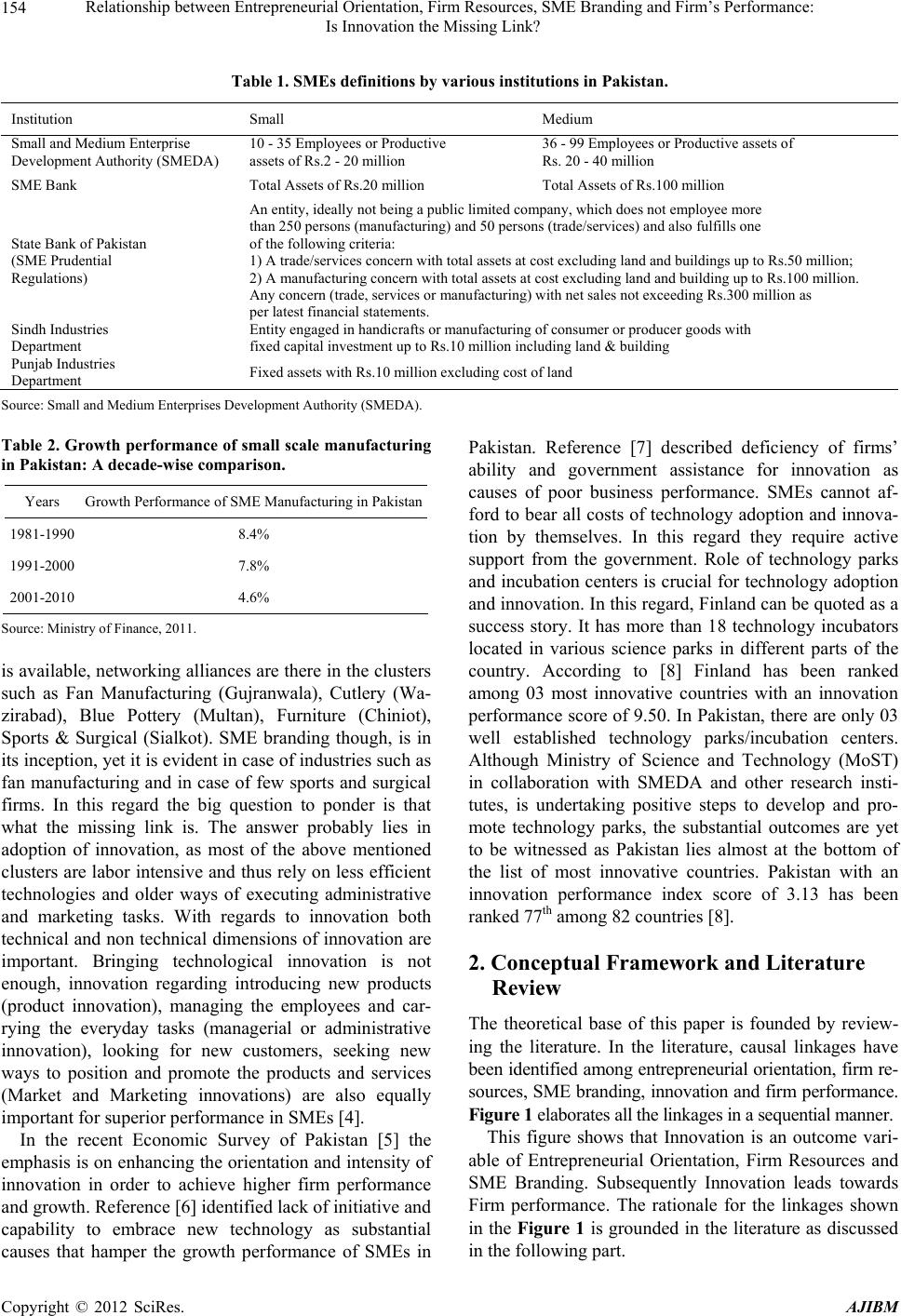 Relationship between Entrepreneurial Orientation, Firm Resources, SME Branding and Firm’s Performance: Is Innovation the Missing Link? 154 Table 1. SMEs definitions by various institutions in Pakistan. Institution Small Medium Small and Medium Enterpri s e Development Authority (SMEDA) 10 - 35 Employees or Productive assets of Rs.2 - 20 million 36 - 99 Employees or Productive assets of Rs. 20 - 40 million SME Bank Total Assets of Rs.20 million Total Assets of Rs.100 million State Bank of Pakistan (SME Prudential Regulations) An entity, ideally not being a public limited company, which does not employee more than 250 persons (manufacturing) and 50 persons (trade/services) and also fulfills one of the following criteria: 1) A trade/services concern with total assets at cost excluding land and buildings up to Rs.50 million; 2) A manufacturing concern with total assets at cost excluding land and building up to Rs.100 million. Any concern (trade, services or manufacturing) with net sales not exceeding Rs.300 million as per latest financial statements. Sindh Industries Department Entity engaged in handicrafts or manufacturing of consumer or producer goods with fixed capital investment up to Rs.10 million including land & building Punjab Industries Department Fixed assets with Rs.10 million excluding cost of land Source: Small and Medium Enterprises D evelopment Authority (SMEDA ) . Table 2. Growth performanc e of small scale manufacturing in Pakistan: A decade-wise comparison. Years Growth Performance of SME Manufacturing in Pakistan 1981-1990 8.4% 1991-2000 7.8% 2001-2010 4.6% Source: Ministry of Finance, 2011. is available, networking alliances are there in the clu sters such as Fan Manufacturing (Gujranwala), Cutlery (Wa- zirabad), Blue Pottery (Multan), Furniture (Chiniot), Sports & Surgical (Sialkot). SME branding though, is in its inception, yet it is evid ent in case of ind ustries such as fan manufacturing and in case of few sports and surgical firms. In this regard the big question to ponder is that what the missing link is. The answer probably lies in adoption of innovation, as most of the above mentioned clusters are labor intensiv e and thus rely on less efficient technologies and older ways of executing administrative and marketing tasks. With regards to innovation both technical and non technical dimensions of innovation are important. Bringing technological innovation is not enough, innovation regarding introducing new products (product innovation), managing the employees and car- rying the everyday tasks (managerial or administrative innovation), looking for new customers, seeking new ways to position and promote the products and services (Market and Marketing innovations) are also equally important for superior performance in SMEs [4]. In the recent Economic Survey of Pakistan [5] the emphasis is on enhancing the orientation and intensity of innovation in order to achieve higher firm performance and growth. Reference [6] identified lack of initiativ e and capability to embrace new technology as substantial causes that hamper the growth performance of SMEs in Pakistan. Reference [7] described deficiency of firms’ ability and government assistance for innovation as causes of poor business performance. SMEs cannot af- ford to bear all costs of technology adoption and innova- tion by themselves. In this regard they require active support from the government. Role of technology parks and incubation centers is crucial for techno logy adoption and innovation. In th is regard, Finlan d can be quoted as a success story. It has more than 18 technology incubators located in various science parks in different parts of the country. According to [8] Finland has been ranked among 03 most innovative countries with an innovation performance score of 9.50. In Pakistan, there are only 03 well established technology parks/incubation centers. Although Ministry of Science and Technology (MoST) in collaboration with SMEDA and other research insti- tutes, is undertaking positive steps to develop and pro- mote technology parks, the substantial outcomes are yet to be witnessed as Pakistan lies almost at the bottom of the list of most innovative countries. Pakistan with an innovation performance index score of 3.13 has been ranked 77th among 82 countries [8]. 2. Conceptual Framework and Literature Review The theoretical base of this paper is founded by review- ing the literature. In the literature, causal linkages have been identified among entrepreneurial orientation, firm re- sources, SME branding, innovation and firm performance. Figure 1 elaborates all the linkages in a sequential m anner. This figure shows that Innovation is an outcome vari- able of Entrepreneurial Orientation, Firm Resources and SME Branding. Subsequently Innovation leads towards Firm performance. The rationale for the linkages shown in the Figure 1 is grounded in the literature as discussed in the following part. Copyright © 2012 SciRes. AJIBM 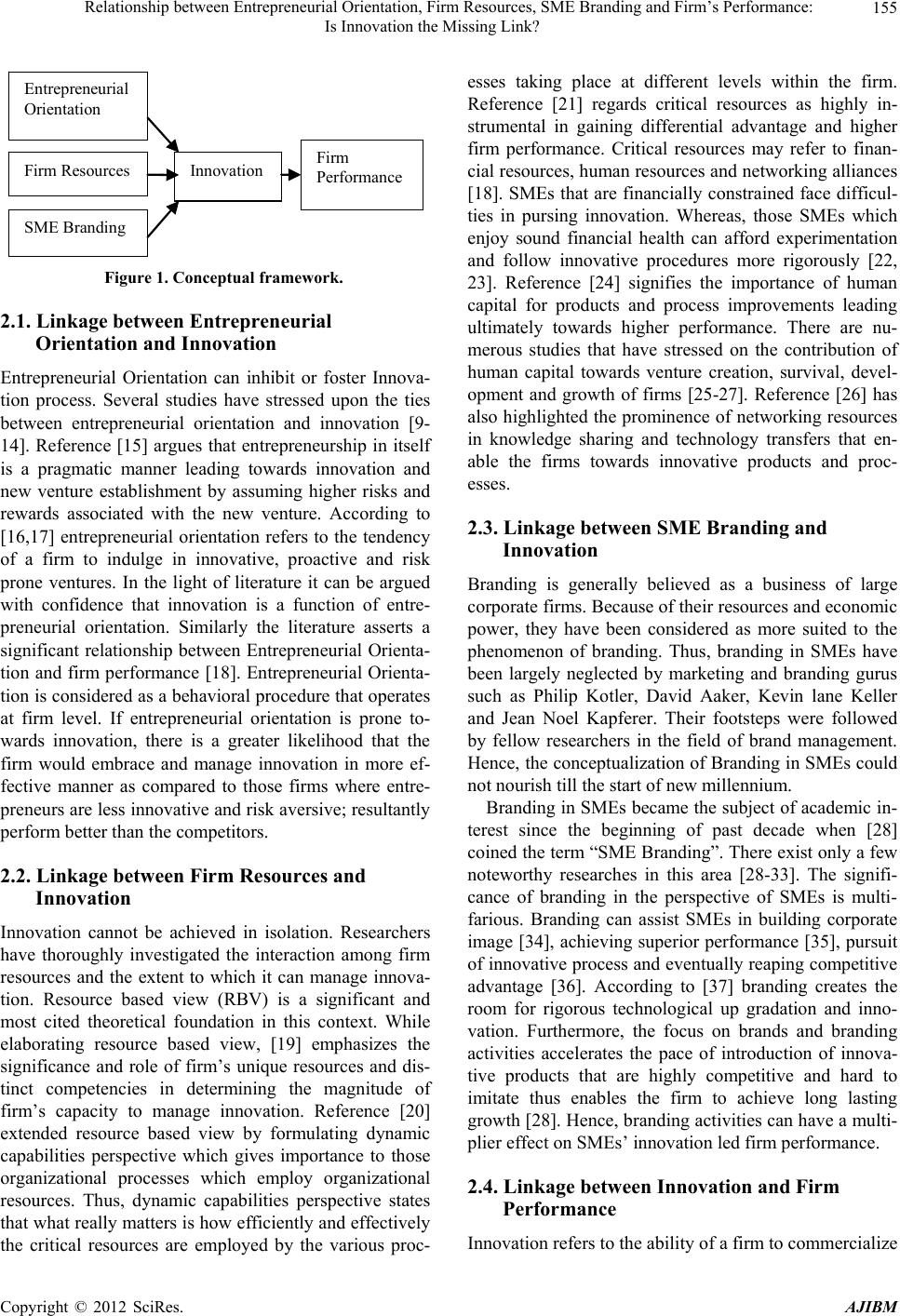 Relationship between Entrepreneurial Orientation, Firm Resources, SME Branding and Firm’s Performance: Is Innovation the Missing Link? 155 Entrepreneurial Orientation Firm Resour ces Innovation SME Bra n d ing Firm Performance Figure 1. Conceptual framework. 2.1. Linkage between Entrepreneurial Orientation and Innovation Entrepreneurial Orientation can inhibit or foster Innova- tion process. Several studies have stressed upon the ties between entrepreneurial orientation and innovation [9- 14]. Reference [15] argues that entrepreneurship in itself is a pragmatic manner leading towards innovation and new venture establishment by assuming higher risks and rewards associated with the new venture. According to [16,17] entrepreneurial orientation refers to the tendency of a firm to indulge in innovative, proactive and risk prone ventures. In the light of literature it can be argued with confidence that innovation is a function of entre- preneurial orientation. Similarly the literature asserts a significant relationship between Entrepreneurial Orienta- tion and firm performance [18]. Entrepreneurial Orienta- tion is considered as a behavioral procedure that operates at firm level. If entrepreneurial orientation is prone to- wards innovation, there is a greater likelihood that the firm would embrace and manage innovation in more ef- fective manner as compared to those firms where entre- preneurs are less innov ative and risk aversive; resu ltantly perform better than the competitors. 2.2. Linkage between Firm Resources and Innovation Innovation cannot be achieved in isolation. Researchers have thoroughly investigated the interaction among firm resources and the extent to which it can manage innova- tion. Resource based view (RBV) is a significant and most cited theoretical foundation in this context. While elaborating resource based view, [19] emphasizes the significance and role of firm’s unique resources and dis- tinct competencies in determining the magnitude of firm’s capacity to manage innovation. Reference [20] extended resource based view by formulating dynamic capabilities perspective which gives importance to those organizational processes which employ organizational resources. Thus, dynamic capabilities perspective states that what really matters is how efficiently and effectively the critical resources are employed by the various proc- esses taking place at different levels within the firm. Reference [21] regards critical resources as highly in- strumental in gaining differential advantage and higher firm performance. Critical resources may refer to finan- cial resources, human resources and n etworking allian ces [18]. SMEs that are financially constrained face difficul- ties in pursing innovation. Whereas, those SMEs which enjoy sound financial health can afford experimentation and follow innovative procedures more rigorously [22, 23]. Reference [24] signifies the importance of human capital for products and process improvements leading ultimately towards higher performance. There are nu- merous studies that have stressed on the contribution of human capital towards venture creation, survival, devel- opment and growth of firms [25-27]. Reference [26] has also highlighted the prominence of networking resources in knowledge sharing and technology transfers that en- able the firms towards innovative products and proc- esses. 2.3. Linkage between SME Branding and Innovation Branding is generally believed as a business of large corporate firms. Because of their resources and economic power, they have been considered as more suited to the phenomenon of branding. Thus, branding in SMEs have been largely neglected by marketing and branding gurus such as Philip Kotler, David Aaker, Kevin lane Keller and Jean Noel Kapferer. Their footsteps were followed by fellow researchers in the field of brand management. Hence, the conceptualization of Branding in SMEs could not nourish till the start of new millennium. Branding in SMEs became the subject of academic in- terest since the beginning of past decade when [28] coined the term “SME Branding”. There exist only a few noteworthy researches in this area [28-33]. The signifi- cance of branding in the perspective of SMEs is multi- farious. Branding can assist SMEs in building corporate image [34], achieving superior performance [35], pursuit of innovative process and ev entually reaping competitive advantage [36]. According to [37] branding creates the room for rigorous technological up gradation and inno- vation. Furthermore, the focus on brands and branding activities accelerates the pace of introduction of innova- tive products that are highly competitive and hard to imitate thus enables the firm to achieve long lasting growth [28]. Hence, brand ing activities can have a multi- plier effect on SMEs’ innovation led firm performance. 2.4. Linkage between Innovation and Firm Performance Innovation refers to the ability of a firm to commercialize Copyright © 2012 SciRes. AJIBM 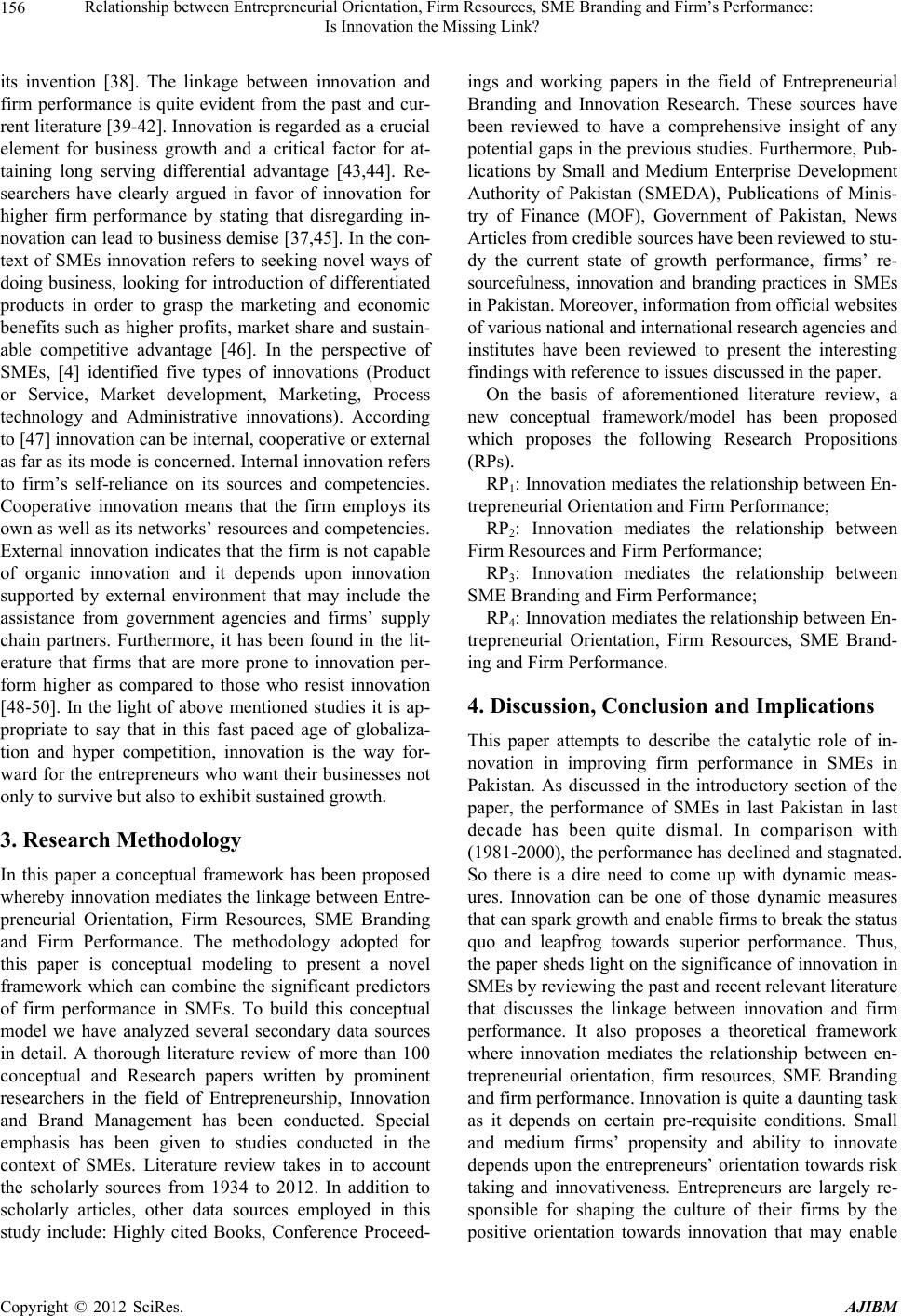 Relationship between Entrepreneurial Orientation, Firm Resources, SME Branding and Firm’s Performance: Is Innovation the Missing Link? 156 its invention [38]. The linkage between innovation and firm performance is quite evident from the past and cur- rent literature [39-42]. Innovation is regarded as a crucial element for business growth and a critical factor for at- taining long serving differential advantage [43,44]. Re- searchers have clearly argued in favor of innovation for higher firm performance by stating that disregarding in- novation can lead to business demise [37,45]. In the con- text of SMEs innovation refers to seeking novel ways of doing business, looking for introduction of differentiated products in order to grasp the marketing and economic benefits such as higher profits, market share and sustain- able competitive advantage [46]. In the perspective of SMEs, [4] identified five types of innovations (Product or Service, Market development, Marketing, Process technology and Administrative innovations). According to [47] innovation can be internal, cooperative or external as far as its mode is concerned. Internal innovation refers to firm’s self-reliance on its sources and competencies. Cooperative innovation means that the firm employs its own as well as its networks’ resources and competencies. External innovation indicates that the firm is not capable of organic innovation and it depends upon innovation supported by external environment that may include the assistance from government agencies and firms’ supply chain partners. Furthermore, it has been found in the lit- erature that firms that are more prone to innovation per- form higher as compared to those who resist innovation [48-50]. In the light of above mentioned studies it is ap- propriate to say that in this fast paced age of globaliza- tion and hyper competition, innovation is the way for- ward for the en trepreneurs wh o want their businesses not only to surviv e but also to exhibit sustained growth. 3. Research Methodology In this paper a conceptual framework has been proposed whereby innovation mediates the linkage between Entre- preneurial Orientation, Firm Resources, SME Branding and Firm Performance. The methodology adopted for this paper is conceptual modeling to present a novel framework which can combine the significant predictors of firm performance in SMEs. To build this conceptual model we have analyzed several secondary data sources in detail. A thorough literature review of more than 100 conceptual and Research papers written by prominent researchers in the field of Entrepreneurship, Innovation and Brand Management has been conducted. Special emphasis has been given to studies conducted in the context of SMEs. Literature review takes in to account the scholarly sources from 1934 to 2012. In addition to scholarly articles, other data sources employed in this study include: Highly cited Books, Conference Proceed- ings and working papers in the field of Entrepreneurial Branding and Innovation Research. These sources have been reviewed to have a comprehensive insight of any potential gaps in the previous studies. Furthermore, Pub- lications by Small and Medium Enterprise Development Authority of Pakistan (SMEDA), Publications of Minis- try of Finance (MOF), Government of Pakistan, News Articles from credible sources have been reviewed to stu- dy the current state of growth performance, firms’ re- sourcefulness, innovation and branding practices in SMEs in Pakistan. Moreover, information from official websites of various national and international research agencies a n d institutes have been reviewed to present the interesting findings with reference to issues discussed in the p aper. On the basis of aforementioned literature review, a new conceptual framework/model has been proposed which proposes the following Research Propositions (RPs). RP1: Innovation mediates the relation ship between En- trepreneurial Orientation and Firm Performance; RP2: Innovation mediates the relationship between Firm Resources and Firm Performance; RP3: Innovation mediates the relationship between SME Branding and Firm Performance; RP4: Innovation mediates the relation ship between En- trepreneurial Orientation, Firm Resources, SME Brand- ing and Firm Performance. 4. Discussion, Conclusion and Implications This paper attempts to describe the catalytic role of in- novation in improving firm performance in SMEs in Pakistan. As discussed in the introductory section of the paper, the performance of SMEs in last Pakistan in last decade has been quite dismal. In comparison with (1981-2000), the performance has declined and stagnated. So there is a dire need to come up with dynamic meas- ures. Innovation can be one of those dynamic measures that can spark growth and enable firms to break the status quo and leapfrog towards superior performance. Thus, the paper sheds light on the significance of innovation in SMEs by reviewing the past and recent relevan t literature that discusses the linkage between innovation and firm performance. It also proposes a theoretical framework where innovation mediates the relationship between en- trepreneurial orientation, firm resources, SME Branding and firm perf ormance. I nno v ation is q uite a d aun ting task as it depends on certain pre-requisite conditions. Small and medium firms’ propensity and ability to innovate depends upon the entrepreneurs’ orientation towards risk taking and innovativeness. Entrepreneurs are largely re- sponsible for shaping the culture of their firms by the positive orientation towards innovation that may enable Copyright © 2012 SciRes. AJIBM 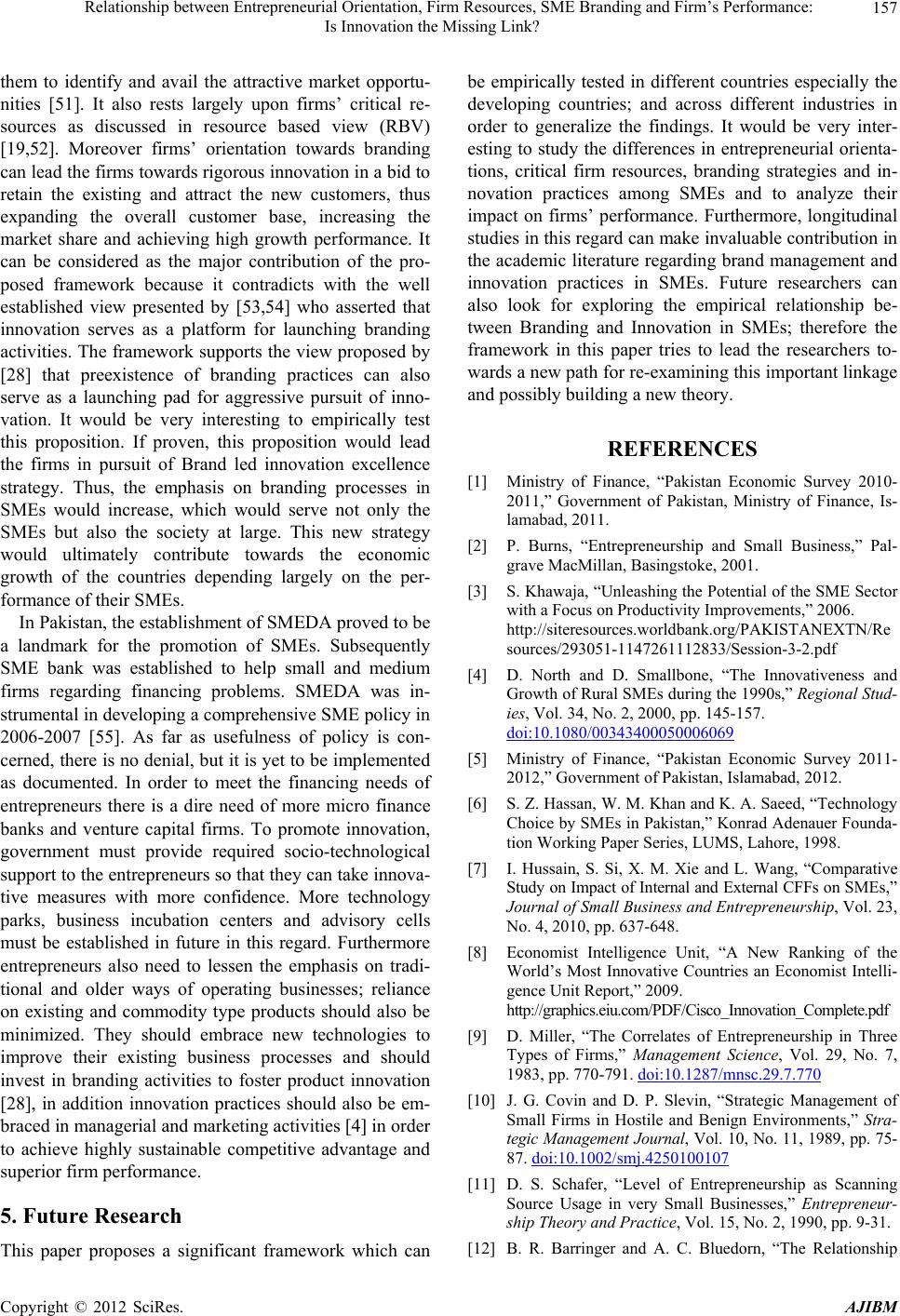 Relationship between Entrepreneurial Orientation, Firm Resources, SME Branding and Firm’s Performance: Is Innovation the Missing Link? 157 them to identify and avail the attractive market opportu- nities [51]. It also rests largely upon firms’ critical re- sources as discussed in resource based view (RBV) [19,52]. Moreover firms’ orientation towards branding can lead the firms towards rigorous innovation in a bid to retain the existing and attract the new customers, thus expanding the overall customer base, increasing the market share and achieving high growth performance. It can be considered as the major contribution of the pro- posed framework because it contradicts with the well established view presented by [53,54] who asserted that innovation serves as a platform for launching branding activities. The framework supports the view proposed by [28] that preexistence of branding practices can also serve as a launching pad for aggressive pursuit of inno- vation. It would be very interesting to empirically test this proposition. If proven, this proposition would lead the firms in pursuit of Brand led innovation excellence strategy. Thus, the emphasis on branding processes in SMEs would increase, which would serve not only the SMEs but also the society at large. This new strategy would ultimately contribute towards the economic growth of the countries depending largely on the per- formance of their SMEs. In Pakistan, the establishment of SMEDA proved to b e a landmark for the promotion of SMEs. Subsequently SME bank was established to help small and medium firms regarding financing problems. SMEDA was in- strumental in developing a comprehen sive SME po licy in 2006-2007 [55]. As far as usefulness of policy is con- cerned, there is no denial, but it is yet to be i mplemented as documented. In order to meet the financing needs of entrepreneurs there is a dire need of more micro finance banks and venture capital firms. To promote innovation, government must provide required socio-technological support to the entr epreneur s so that they can take innova- tive measures with more confidence. More technology parks, business incubation centers and advisory cells must be established in future in this regard. Furthermore entrepreneurs also need to lessen the emphasis on tradi- tional and older ways of operating businesses; reliance on existing and commodity type products should also be minimized. They should embrace new technologies to improve their existing business processes and should invest in branding activities to foster product innovation [28], in addition innovation practices should also be em- braced in managerial and marketing activ ities [4 ] in ord er to achieve highly sustainable competitive advantage and superior firm performance. 5. Future Research This paper proposes a significant framework which can be empirically tested in different countries especially the developing countries; and across different industries in order to generalize the findings. It would be very inter- esting to study the differences in entrepreneurial orienta- tions, critical firm resources, branding strategies and in- novation practices among SMEs and to analyze their impact on firms’ performance. Furthermore, longitudinal studies in this regard can make invaluable contribution in the academic literature regarding brand management and innovation practices in SMEs. Future researchers can also look for exploring the empirical relationship be- tween Branding and Innovation in SMEs; therefore the framework in this paper tries to lead the researchers to- wards a new path for re-examining this important linkage and possibly building a new theory. REFERENCES [1] Ministry of Finance, “Pakistan Economic Survey 2010- 2011,” Government of Pakistan, Ministry of Finance, Is- lamabad, 2011. [2] P. Burns, “Entrepreneurship and Small Business,” Pal- grave MacMillan, Basingstoke, 2001. [3] S. Khawaja, “Unleashing the Potential of the SME Sector with a Focus on Productivity Improvements,” 2006. http://siteresources.worldbank.org/PAKISTANEXTN/Re sources/293051-1147261112833/Session-3-2.pdf [4] D. North and D. Smallbone, “The Innovativeness and Growth of Rural SMEs during the 1990s,” Regional Stud- ies, Vol. 34, No. 2, 2000, pp. 145-157. doi:10.1080/00343400050006069 [5] Ministry of Finance, “Pakistan Economic Survey 2011- 2012,” Government of Pakistan, Islamabad, 2012. [6] S. Z. Hassan, W. M. Khan and K. A. Saeed, “Technology Choice by SMEs in Pakistan,” Konrad Adenauer Founda- tion Working Paper Series, LUMS, Lahore, 1998. [7] I. Hussain, S. Si, X. M. Xie and L. Wang, “Comparative Study on Impact of Internal and External CFFs on SM Es, ” Journal of Small Business and Entrepreneurship, Vol. 23, No. 4, 2010, pp. 637-648. [8] Economist Intelligence Unit, “A New Ranking of the World’s Most Innovative Countries an Economist Intelli- gence Unit Report,” 2009. http://graphics.eiu.com/PDF/Cisco_Innovation_Complete.pdf [9] D. Miller, “The Correlates of Entrepreneurship in Three Types of Firms,” Management Science, Vol. 29, No. 7, 1983, pp. 770-791. doi:10.1287/mnsc.29.7.770 [10] J. G. Covin and D. P. Slevin, “Strategic Management of Small Firms in Hostile and Benign Environments,” Stra- tegic Management Journal, Vol. 10, No. 11, 1989, pp. 75- 87. doi:10.1002/smj.4250100107 [11] D. S. Schafer, “Level of Entrepreneurship as Scanning Source Usage in very Small Businesses,” Entrepreneur- ship Theory and Practice, Vol. 15, No. 2, 1990, pp. 9-31. [12] B. R. Barringer and A. C. Bluedorn, “The Relationship Copyright © 2012 SciRes. AJIBM 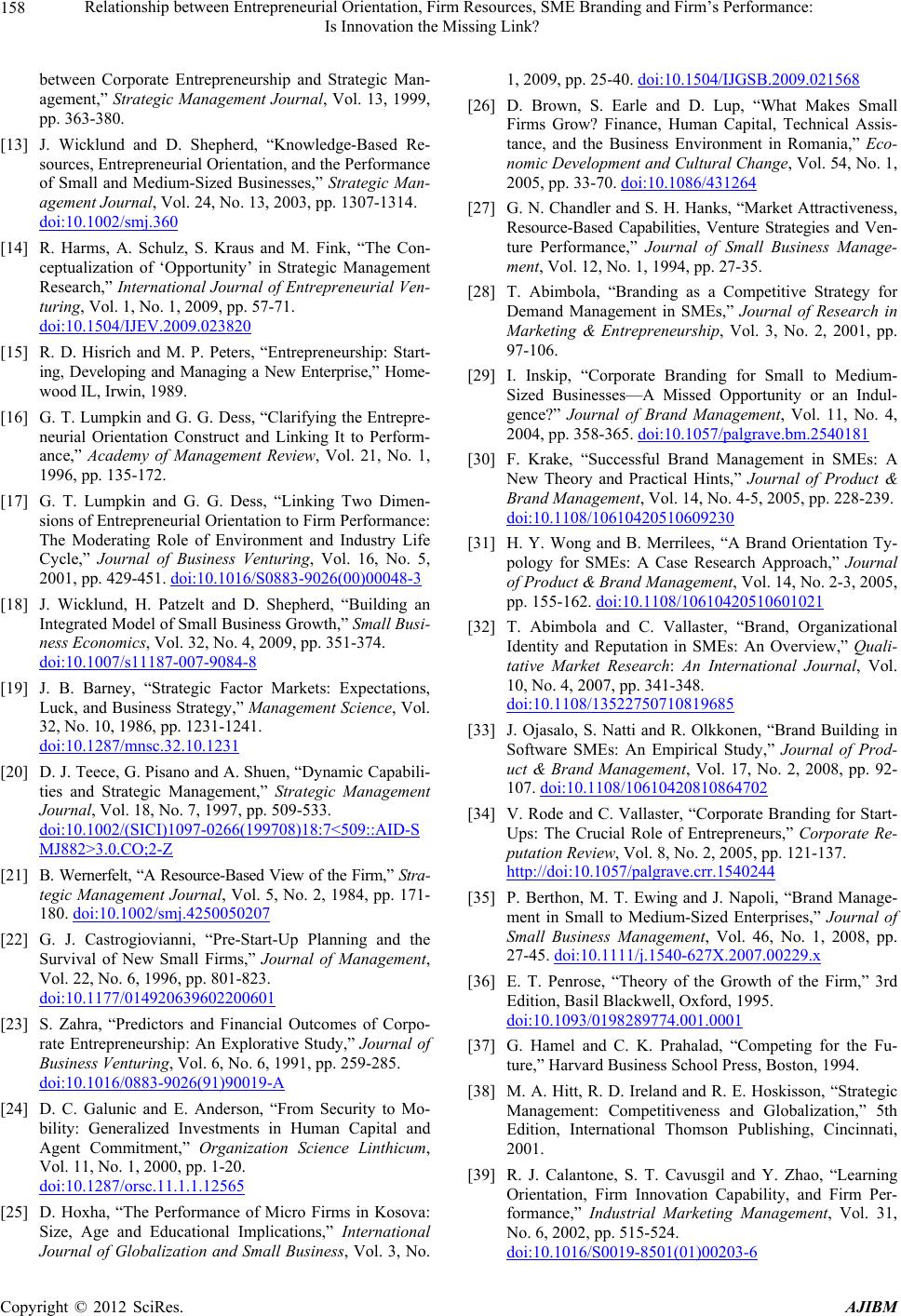 Relationship between Entrepreneurial Orientation, Firm Resources, SME Branding and Firm’s Performance: Is Innovation the Missing Link? 158 between Corporate Entrepreneurship and Strategic Man- agement,” Strategic Management Journal, Vol. 13, 1999, pp. 363-380. [13] J. Wicklund and D. Shepherd, “Knowledge-Based Re- sources, Entrepreneurial Orientation, and the Performance of Small and Medium-Sized Businesses,” Strategic Man- agement Journal, Vol. 24, No. 13, 2003, pp. 1307-1314. doi:10.1002/smj.360 [14] R. Harms, A. Schulz, S. Kraus and M. Fink, “The Con- ceptualization of ‘Opportunity’ in Strategic Management Research,” International Journal of Entrepreneurial Ven- turing, Vol. 1, No. 1, 2009, pp. 57-71. doi:10.1504/IJEV.2009.023820 [15] R. D. Hisrich and M. P. Peters, “Entrepreneurship: Start- ing, Developing and Managing a New Enterprise,” Home- wood IL, Irwin, 1989. [16] G. T. Lumpkin and G. G. Dess, “Clarifying the Entrepre- neurial Orientation Construct and Linking It to Perform- ance,” Academy of Management Review, Vol. 21, No. 1, 1996, pp. 135-172. [17] G. T. Lumpkin and G. G. Dess, “Linking Two Dimen- sions of Entrepreneurial Orientation to Firm Performance: The Moderating Role of Environment and Industry Life Cycle,” Journal of Business Venturing, Vol. 16, No. 5, 2001, pp. 429-451. doi:10.1016/S0883-9026(00)00048-3 [18] J. Wicklund, H. Patzelt and D. Shepherd, “Building an Integrated Model of Small Business Growth,” Small Busi- ness Economics, Vol. 32, No. 4, 2009, pp. 351-374. doi:10.1007/s11187-007-9084-8 [19] J. B. Barney, “Strategic Factor Markets: Expectations, Luck, and B usiness Strate gy,” Management Science, Vol. 32, No. 10, 1986, pp. 1231-1241. doi:10.1287/mnsc.32.10.1231 [20] D. J. Teece, G. Pisano and A. Shuen, “Dynamic Capabili- ties and Strategic Management,” Strategic Management Journal, Vol. 18, No. 7, 1997, pp. 509-533. doi:10.1002/(SICI)1097-0266(199708)18:7<509::AID-S MJ882>3.0.CO;2-Z [21] B. Wernerfelt, “A Resource-Based View of the Firm, ” Stra- tegic Management Journal, Vol. 5, No. 2, 1984, pp. 171- 180. doi:10.1002/smj.4250050207 [22] G. J. Castrogiovianni, “Pre-Start-Up Planning and the Survival of New Small Firms,” Journal of Management, Vol. 22, No. 6, 1996, pp. 801-823. doi:10.1177/014920639602200601 [23] S. Zahra, “Predictors and Financial Outcomes of Corpo- rate Entrepreneurship: An Explorative Study,” Journal of Business Venturing, Vol. 6, No. 6, 1991, pp. 259-285. doi:10.1016/0883-9026(91)90019-A [24] D. C. Galunic and E. Anderson, “From Security to Mo- bility: Generalized Investments in Human Capital and Agent Commitment,” Organization Science Linthicum, Vol. 11, No. 1, 2000, pp. 1-20. doi:10.1287/orsc.11.1.1.12565 [25] D. Hoxha, “The Performance of Micro Firms in Kosova: Size, Age and Educational Implications,” International Journal of Globalization and Small Business, Vol. 3, No. 1, 2009, pp. 25-40. doi:10.1504/IJGSB.2009.021568 [26] D. Brown, S. Earle and D. Lup, “What Makes Small Firms Grow? Finance, Human Capital, Technical Assis- tance, and the Business Environment in Romania,” Eco- nomic Development and Cultural Change, Vol. 54, No. 1, 2005, pp. 33-70. doi:10.1086/431264 [27] G. N. Chandler and S. H. Hanks, “Market Attractiveness, Resource-Based Capabilities, Venture Strategies and Ven- ture Performance,” Journal of Small Business Manage- ment, Vol. 12, No. 1, 1994, pp. 27-35. [28] T. Abimbola, “Branding as a Competitive Strategy for Demand Management in SMEs,” Journal of Research in Marketing & Entrepreneurship, Vol. 3, No. 2, 2001, pp. 97-106. [29] I. Inskip, “Corporate Branding for Small to Medium- Sized Businesses—A Missed Opportunity or an Indul- gence?” Journal of Brand Management, Vol. 11, No. 4, 2004, pp. 358-365. doi:10.1057/palgrave.bm.2540181 [30] F. Krake, “Successful Brand Management in SMEs: A New Theory and Practical Hints,” Journal of Product & Brand Management, Vol. 14, No. 4-5, 2005, pp. 228-239. doi:10.1108/10610420510609230 [31] H. Y. Wong and B. Merrilees, “A Brand Orientation Ty- pology for SMEs: A Case Research Approach,” Journal of Product & Brand Management, Vol. 14, No. 2-3, 2005, pp. 155-162. doi:10.1108/10610420510601021 [32] T. Abimbola and C. Vallaster, “Brand, Organizational Identity and Reputation in SMEs: An Overview,” Quali- tative Market Research: An International Journal, Vol. 10, No. 4, 2007, pp. 341-348. doi:10.1108/13522750710819685 [33] J. Ojasalo, S. Natti and R. Olkkonen, “Brand Building in Software SMEs: An Empirical Study,” Journal of Prod- uct & Brand Management, Vol. 17, No. 2, 2008, pp. 92- 107. doi:10.1108/10610420810864702 [34] V. Rode and C. Vallaster, “Corporate Branding for Start- Ups: The Crucial Role of Entrepreneurs,” Corporate Re- putation Review, Vol. 8, No. 2, 2005, pp. 121-137. http://doi:10.1057/palgrave.crr.1540244 [35] P. Berthon, M. T. Ewing and J. Napoli, “Brand Manage- ment in Small to Medium-Sized Enterprises,” Journal of Small Business Management, Vol. 46, No. 1, 2008, pp. 27-45. doi:10.1111/j.1540-627X.2007.00229.x [36] E. T. Penrose, “Theory of the Growth of the Firm,” 3rd Edition, Basil Blackwell, Oxford, 1995. doi:10.1093/0198289774.001.0001 [37] G. Hamel and C. K. Prahalad, “Competing for the Fu- ture,” Harvard Business School Press, Boston, 1994. [38] M. A. Hitt, R. D. Ireland and R. E. Hoskisson, “Strategic Management: Competitiveness and Globalization,” 5th Edition, International Thomson Publishing, Cincinnati, 2001. [39] R. J. Calantone, S. T. Cavusgil and Y. Zhao, “Learning Orientation, Firm Innovation Capability, and Firm Per- formance,” Industrial Marketing Management, Vol. 31, No. 6, 2002, pp. 515-524. doi:10.1016/S0019-8501(01)00203-6 Copyright © 2012 SciRes. AJIBM 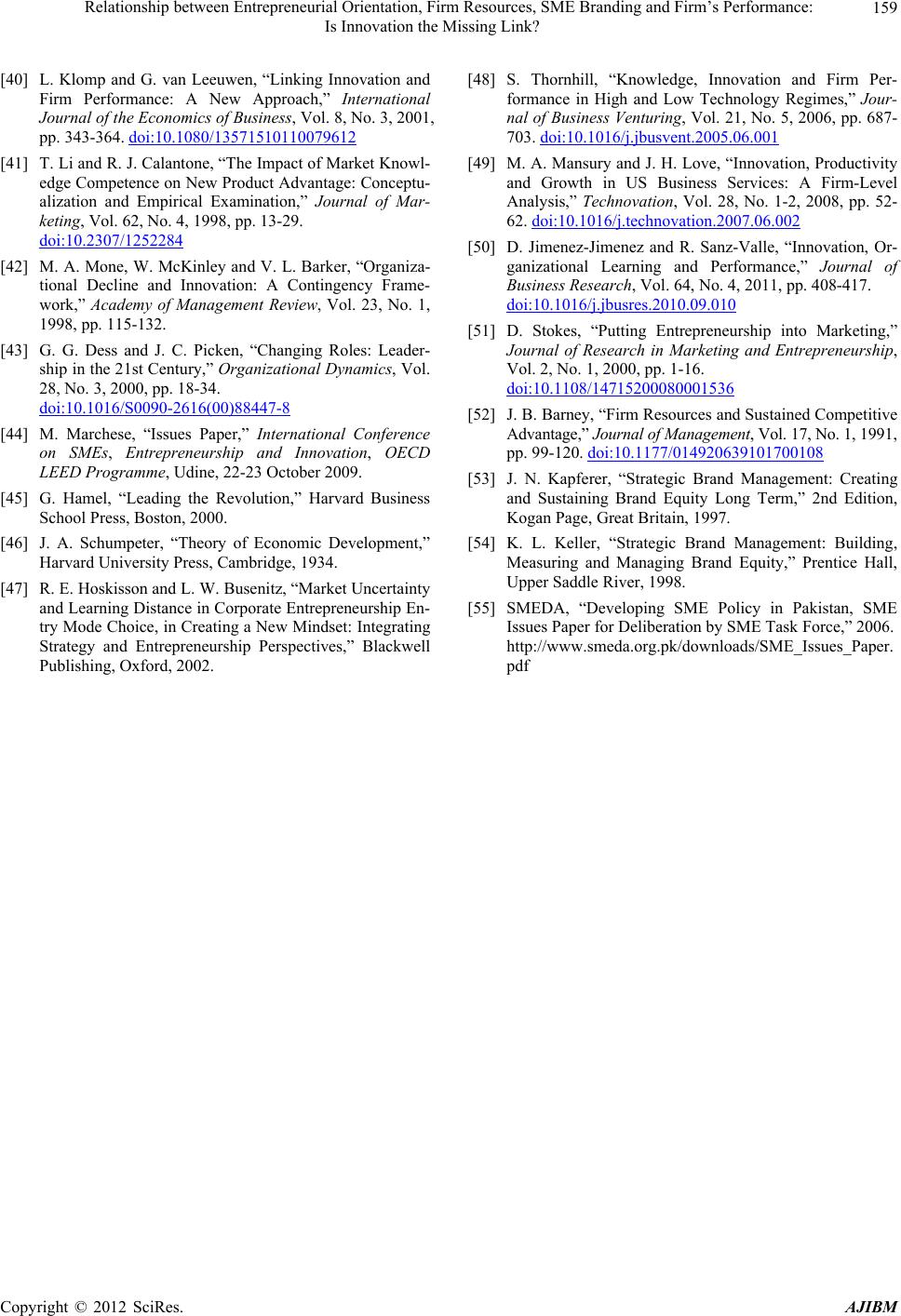 Relationship between Entrepreneurial Orientation, Firm Resources, SME Branding and Firm’s Performance: Is Innovation the Missing Link? Copyright © 2012 SciRes. AJIBM 159 [40] L. Klomp and G. van Leeuwen, “Linking Innovation and Firm Performance: A New Approach,” In ternational Journal of the Economics of Business, Vol. 8, No. 3, 2001, pp. 343-364. doi:10.1080/13571510110079612 [41] T. Li and R. J. Calantone, “The Impact of Market Knowl- edge Competence on New Product Advantage: Conceptu- alization and Empirical Examination,” Journal of Mar- keting, Vol. 62, No. 4, 1998, pp. 13-29. doi:10.2307/1252284 [42] M. A. Mone, W. McKinley and V. L. Barker, “Organiza- tional Decline and Innovation: A Contingency Frame- work,” Academy of Management Review, Vol. 23, No. 1, 1998, pp. 115-132. [43] G. G. Dess and J. C. Picken, “Changing Roles: Leader- ship in the 21st Century,” Organizational Dynamics, Vol. 28, No. 3, 2000, pp. 18-34. doi:10.1016/S0090-2616(00)88447-8 [44] M. Marchese, “Issues Paper,” International Conference on SMEs, Entrepreneurship and Innovation, OECD LEED Programme, Udine, 22-23 October 2009. [45] G. Hamel, “Leading the Revolution,” Harvard Business School Press, Boston, 2000. [46] J. A. Schumpeter, “Theory of Economic Development,” Harvard University Press, Cambridge, 1934. [47] R. E. Hoskisson and L. W. Buseni tz, “Market Unce rtainty and Learning Distance in Corporate Entrepreneurship En- try Mode Choice, in Creating a New Mindset: Integrating Strategy and Entrepreneurship Perspectives,” Blackwell Publishing, Oxford, 2002. [48] S. Thornhill, “Knowledge, Innovation and Firm Per- formance in High and Low Technology Regimes,” Jour- nal of Business Venturing, Vol. 21, No. 5, 2006, pp. 687- 703. doi:10.1016/j.jbusvent.2005.06.001 [49] M. A. Mansury and J. H. Love, “Innovation, Productivity and Growth in US Business Services: A Firm-Level Analysis,” Technovation, Vol. 28, No. 1-2, 2008, pp. 52- 62. doi:10.1016/j.technovation.2007.06.002 [50] D. Jimenez-Jimenez and R. Sanz-Valle, “Innovation, Or- ganizational Learning and Performance,” Journal of Business Research, Vol. 64, No. 4, 2011, pp. 408-417. doi:10.1016/j.jbusres.2010.09.010 [51] D. Stokes, “Putting Entrepreneurship into Marketing,” Journal of Research in Marketing and Entrepreneurship, Vol. 2, No. 1, 2000, pp. 1-16. doi:10.1108/14715200080001536 [52] J. B. Barney, “Firm Resources and Sustained Competitive Advantage,” Journal of Management, Vo l. 17, No. 1, 1991, pp. 99-120. doi:10.1177/014920639101700108 [53] J. N. Kapferer, “Strategic Brand Management: Creating and Sustaining Brand Equity Long Term,” 2nd Edition, Kogan Page, Great Britain, 1997. [54] K. L. Keller, “Strategic Brand Management: Building, Measuring and Managing Brand Equity,” Prentice Hall, Upper Saddle River, 1998. [55] SMEDA, “Developing SME Policy in Pakistan, SME Issues Paper for Deliberation by SME Task Force,” 2006. http://www.smeda.org.pk/downloads/SME_Issues_Paper. pdf
|